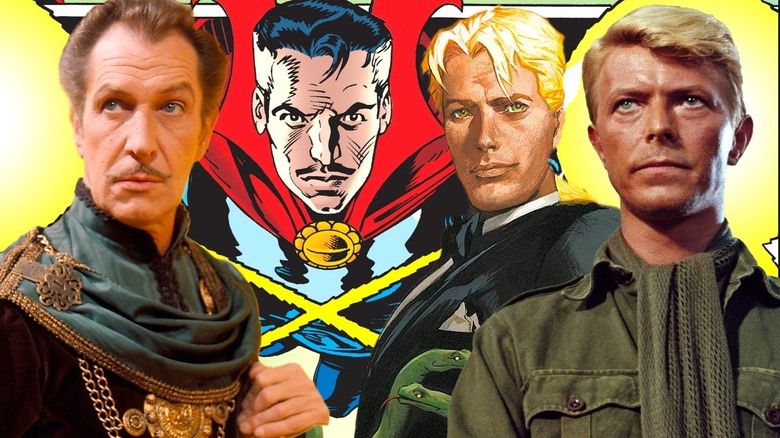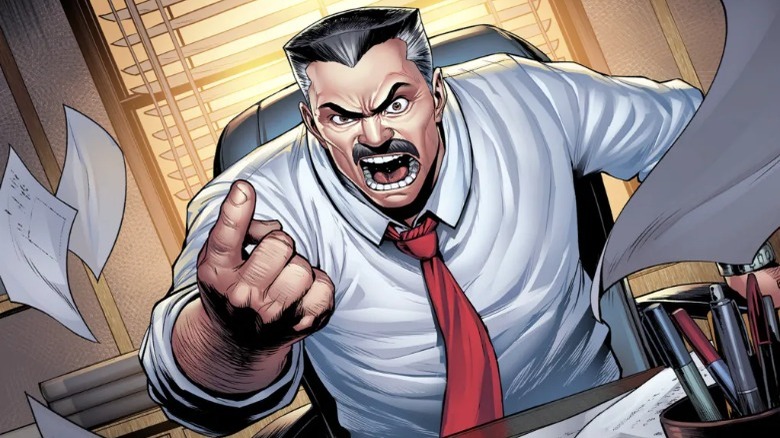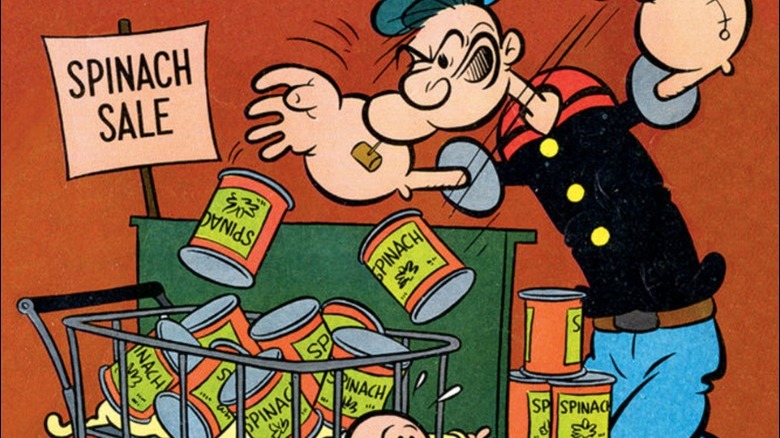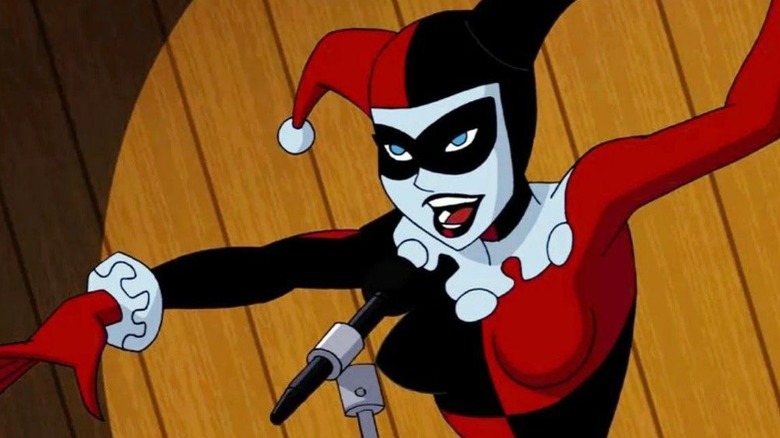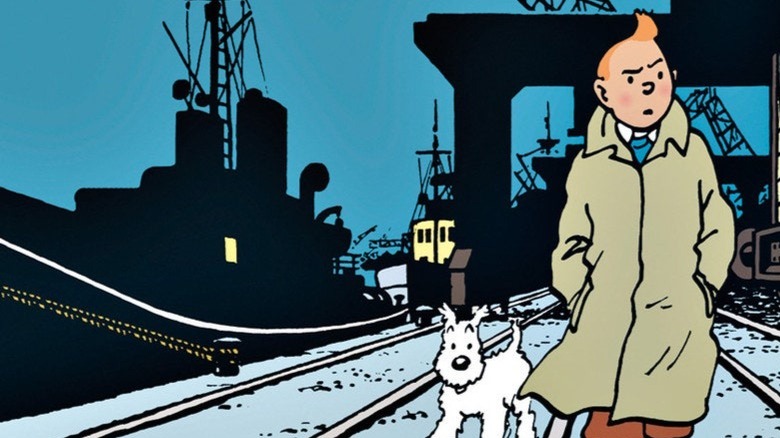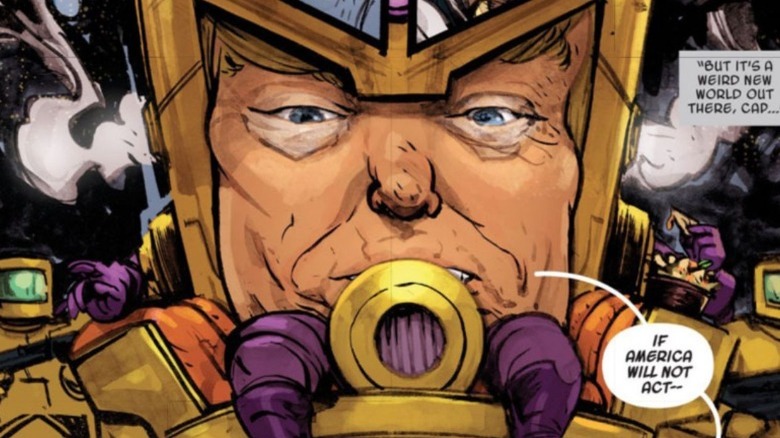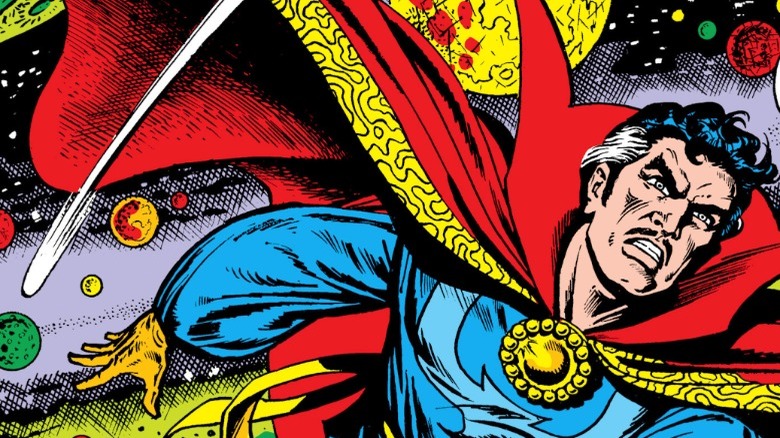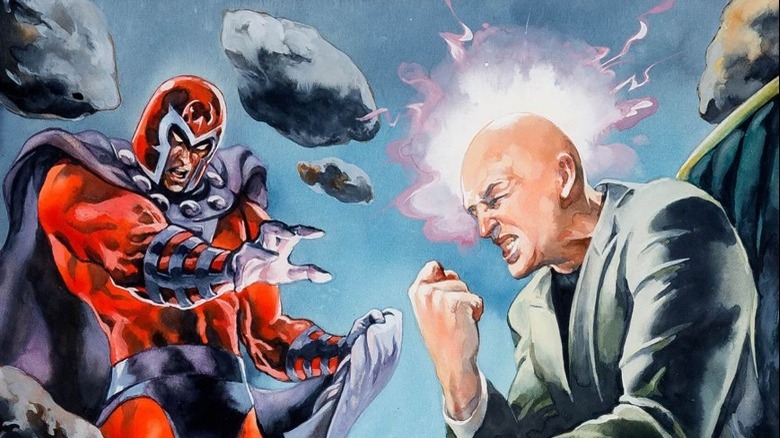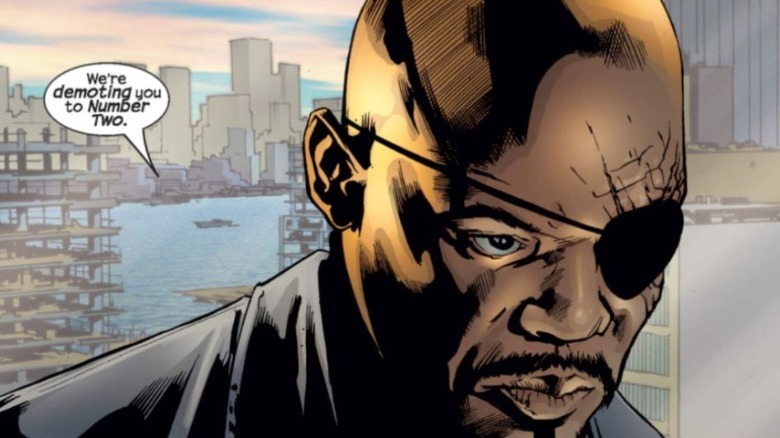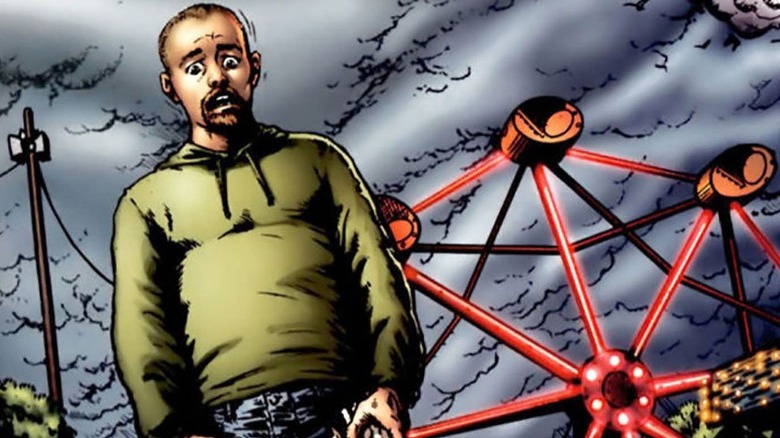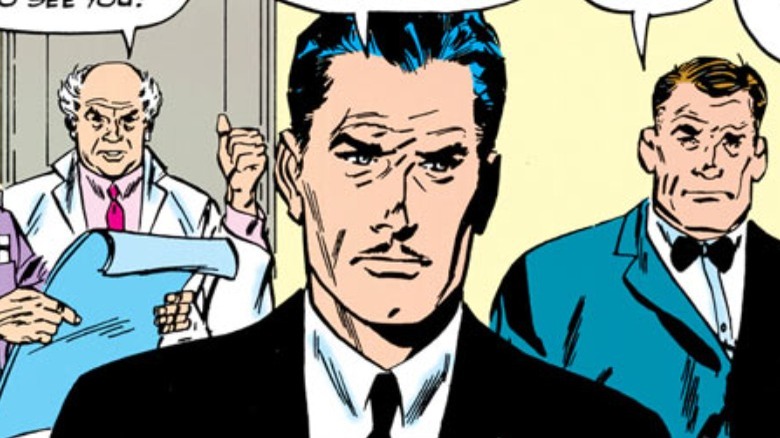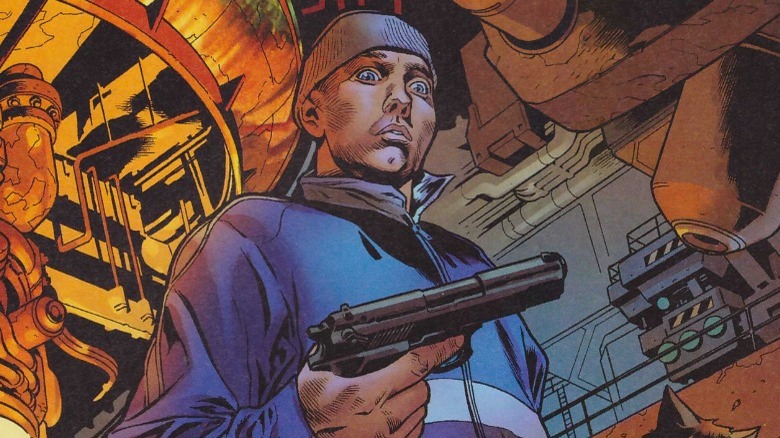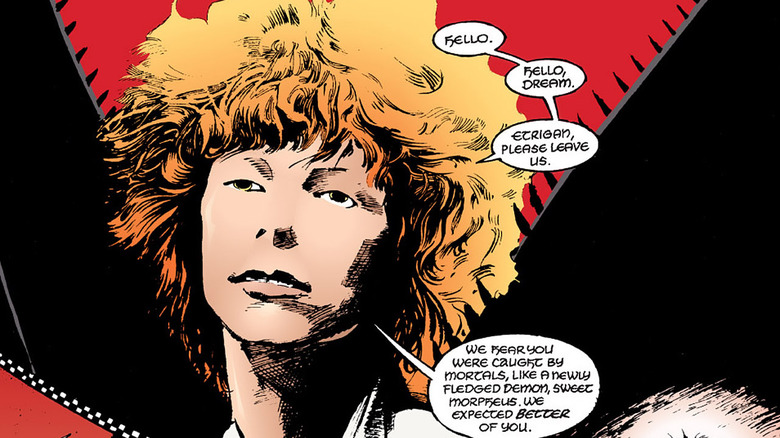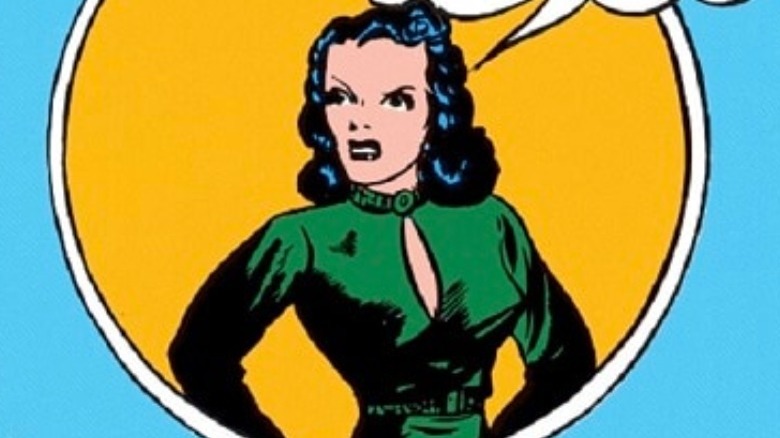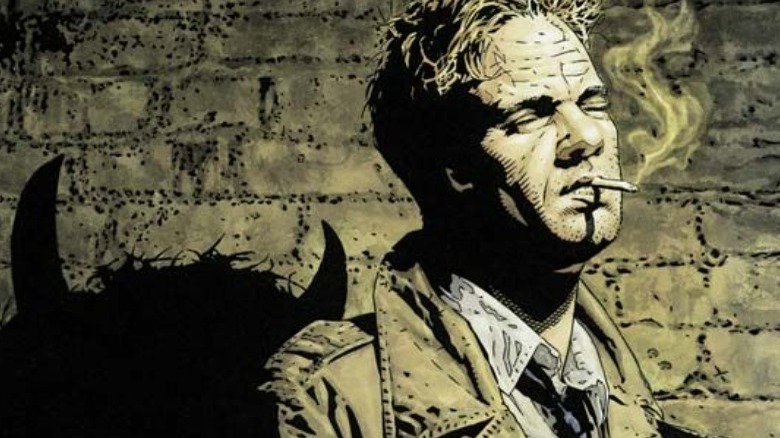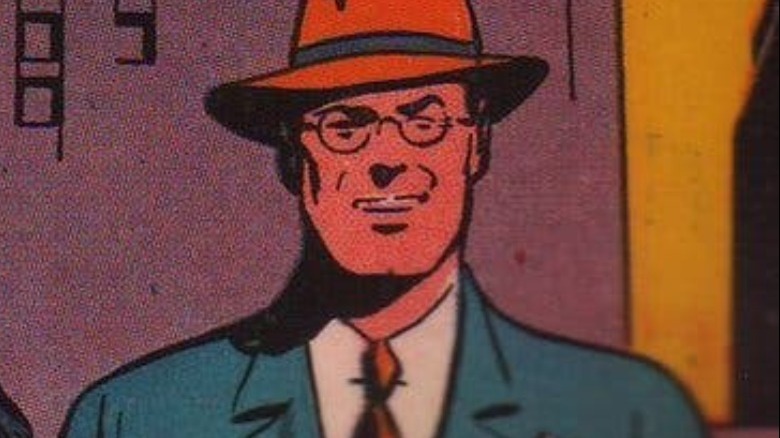Comic Book Characters You Didn't Know Were Based On Real People
Comic book characters are often larger-than-life representations of the kind of people we admire or strive to be. Think of Superman: A godlike character with extraordinary powers. While artists Joe Shuster and Jerry Siegel weren't influenced by real people in creating Superman, instead turning to the works of Edgar Rice Burroughs and others, Clark Kent is far more grounded in reality. Characters like him and others with impressive powers, superior skills, or over-the-top characterizations are often based on real people.
After all, most artists and writers take inspiration from their own lives or the people they know, so it stands to reason that comic book creators are no different. Looking back through nearly a century of comic book publishing, there are far more characters based on or inspired by real people than most fans realize.
Occasionally, an artist will model a character on someone they admire (or revile), and it never hurts to draw inspiration from someone who ... well, inspired them at some point in their lives. Whether they consider it an homage or satire, there are plenty of examples of this in comic book history. All of these characters are relatively well-known, have been featured in either a TV or feature film adaptation, and are based, at least in part, on a real person.
J. Jonah Jameson
J. Jonah Jameson is one of the more fascinating characters in Spider-Man's orbit, as he's been his boss, enemy, mayor, and eventually, his relative. In the beginning, Jameson hates Spider-Man so much that he creates and hires supervillains to try and take him down. Granted, he never expects things to go off the rails like they do, but if it weren't for him, Spidey would have likely never butted heads with the Scorpion, the Spider-Slayer, Mysterio, and others.
Of course, despite all of his anti-Spidey vitriol, Jameson is, at his core, a newspaper publisher. As the editor-in-chief of the Daily Bugle, Jameson sways public opinion, villainizes those he has personal grudges with, and treats his employees like garbage. When Stan "The Man" Lee and Steve Ditko created him in 1963, Lee imagined himself in the role. As such, Jameson is a parody of Lee, and he revealed this theory in a 2010 interview with NPR's "Talk of the Nation."
Lee was asked if he physically modeled Jameson after himself — they bear a striking resemblance, thanks to the mustache, age, and demeanor — but more than that, they have similar jobs with high demands of their staff. To this, Lee admitted, "You caught me. I really did. I thought if I were a grumpy, irritable man, which I am sometimes, how would I act? And that was it. So, you got me."
Popeye
Popeye is one of those beloved figures in animation history. He's been around since 1929, selling spinach throughout the 20th century, and has been featured in cartoons, comic books, comic strips, and even a live-action feature film starring Robin Williams in the titular role. He's Popeye the Sailor Man, and everybody knows him. Most people probably don't know that Popeye was modeled after a real person, though there's some confusion over this, thanks to an oft-shared meme.
You may have seen it — a black-and-white photo of a man who looks exactly like Popeye. E.C. Segar created Popeye, and he used a man named Frank "Rocky" Fiegel as his template. The meme points to several common characteristics, and the photo undeniably resembles Popeye, but the guy in the picture isn't actually Fiegel. In reality, Segar took several aspects of Fiegel, who lived in his hometown, and put them into his design.
Fiegel had a prominent chin, was rarely spotted without his signature pipe, and had a penchant for brawling. According to The New York Times, Fiegel didn't know he inspired Popeye until Segar's death. While Segar never spoke about it, the similarities became folklore in the town of Chester, Illinois. Fiegel died in 1947 and was buried in an unmarked grave. Fortunately, the Official Popeye Fan Club fixed this in 1996 when they erected a headstone bearing an image of Popeye with the epitaph "Inspiration for Popeye the Sailor Man" emblazoned upon the base.
Harley Quinn
Harley Quinn is one of the best-known and loved members of Batman's rogues gallery, which is primarily due to her portrayal in the DCEU by Margot Robbie. Unlike most of the Dark Knight's many villains, Harley didn't debut in the comics: She first appeared in an episode of "Batman: The Animated Series" in 1992. At first, she was the Joker's lover, but she's grown considerably since then and has developed into an antihero in her own right once she left him in the past.
Harley's backstory has been expanded over the years, and she's easily one of the more fascinating characters associated with Batman. While her personality wasn't entirely based on a real person, the impetus for her creation is rather unorthodox, because she was inspired by the woman who went on to voice her: Arlene Sorkin. In the '80s, Sorkin played Calliope Jones on "Days of Our Lives," and in one episode, she played a harlequin-inspired version.
The clip shows Sorkin wearing a red and blue harlequin costume, and she gave a tape of the episode to her friend, Paul Dini, the creative mind behind "Batman: The Animated Series." He worked with Bruce Timm to create the character, using Sorkin as inspiration. Once Harley was developed, Dini brought Sorkin in to do her voice, and she continued to bring life to the character in television series and video games for decades.
Tintin
Tintin is another character who's been around since 1929. While he was well known throughout Belgium and France in the 20th century, many in the United States first met the character in 2011, via Steven Spielberg's "The Adventures of Tintin." Regardless of where you first encountered Tintin, he got his start in "Le Petit Vingtième," a supplement to the Belgian paper, "Le Vingtième Siècle," in a story called "Tintin in the Land of the Soviets." He was published in the paper for years and became the star of his own comic series, cartoons, and feature films.
Tintin was created by Hergé, the pen name used by Georges Remi. He said in his biography, "Herge: The Man Who Created Tintin," that "the idea for the character of Tintin and the sort of adventures that would befall him came to me, I believe, in five minutes, the moment I first made a sketch of the figure of this hero: that is to say, he had not haunted my youth nor even my dreams. Although it's possible that as a child, I imagined myself in the role of a sort of Tintin."
When pressed for more, Hergé' admitted he modeled much of Tintin on his younger brother, Paul. When he came up with Tintin's look, he used some of his own physical traits, but took many from his brother. Another source of inspiration was likely Palle Huld, a Danish actor long believed to be connected to the character. His life and Tintin's are strikingly similar, though Hergé never confirmed this long-held assumption.
M.O.D.A.A.K.
While many are familiar with MODOK primarily from his Hulu animated series or his debut in the Marvel Cinematic Universe via "Ant-Man and the Wasp: Quantumania," the character has been around for a long time. MODOK, or Mechanized Organism Designed Only for Killing, is one of the oddest characters in the Marvel Universe — and that's saying something. His giant head is supported in a floating chair that leaves his appendages dangling. He's evil, he's funny-looking, and he's been around since 1967.
While the original character wasn't modeled after anyone in particular, one version from Marvel's multiverse did find real-life inspiration. In 2016's "Spider Gwen Annual" #1, Marvel introduced MODAAK, which stands for Mental Organism Designed As America's King, and he bears a striking resemblance to Donald Trump. In the comics, Trump joined AIM, where he became MODAAK and was responsible for forcing conscripts to build a wall between Texas and Mexico. He's ultimately defeated by Captain America, who is a Black woman in Earth-65, where the story takes place.
While the depiction is certainly not flattering to Trump, it is clearly meant as satire, and frankly, it's hilarious. When "Spider-Gwen Annual" #1 hit the shelves, Slate predicted it would bring about Trump's political downfall. While that didn't happen — and it's unlikely Trump ever learned of his depiction in Marvel Comics — it remains one of the funniest versions of a former President to be featured in a comic book.
Dr. Stephen Strange
Thanks to Benedict Cumberbatch's portrayal of Doctor Stephen Strange in the MCU, he's one of the most recognizable characters in Marvel's library. Granted, it doesn't hurt that Cumberbatch looks just like the character in the comics, but he had nothing to do with the character's creation. For that, you have to go back to 1963, when Steve Ditko presented the design to Stan Lee, who rushed a five-page story into "Strange Tales" #110.
It took some time, but Dr. Strange developed into a popular character, and he's remained one for decades. Over the years, Lee and many others molded Strange into the one we recognize today, but initially, he was inspired by two people. Strange's origin story, which involves an American traveling to the East to learn magic, is taken from Chandu the Magician, a popular radio show aired in the 1930s. The two have several similarities, and Lee cited Chandu as Strange's key inspiration.
When it came to Dr. Strange's look, Ditko took inspiration from Vincent Price: Specifically, Price's portrayal of Dr. Erasmus Craven in the 1963 comedy gothic horror, "The Raven." Price's pencil mustache, costume, and demeanor fit Strange perfectly, and it's easy to see the influence in Ditko's work. Additionally, Dr. Strange's middle name is Vincent, which was likely chosen as an homage to the man who inspired his look.
Professor Charles Xavier and Magneto
The X-Men were introduced in 1963, which was a turbulent time in the United States. The civil rights movement was in full swing, and people looked to leaders like Dr. Martin Luther King Jr. and Malcolm X for inspiration. Marvel Comics didn't ignore this critical moment in history; it modeled Mutants after oppressed people fighting for equal rights. To this end, Stan Lee and Jack "The King" Kirby unleashed the X-Men, and for the team's leader, they created Professor Charles Xavier.
While the Mutants and their plight in the Marvel Universe mirrored the ongoing civil rights movement, the individual characters weren't necessarily based on anyone — except possibly for Professor X and Magneto. A longstanding rumor sees an allegorical similarity between Professor X and Dr. King due to their pacifist stance in support of societal change. Conversely, the X-Men's primary antagonist, Magneto, was thought to be modeled after Malcolm X, as he chose a less pacifist ideology in his mission for change, though he wasn't violent.
Longtime "X-Men" scribe Chris Claremont told Empire he didn't accept this and preferred to think of "[Israeli Prime Minister] Menachem Begin as Magneto, evolving through his life from a terrorist in 1947 to a winner of the Nobel Peace Prize 30 years later." Regardless of Claremont's take, one thing is certain: Stan Lee based Xavier's physique on Yul Brynner, as he acknowledged in "Stan Lee Conversations."
Nick Fury (Earth-1610)
If you started reading Marvel Comics in 1963 and wondered how Samuel L. Jackson was cast to play Nick Fury in the MCU, you likely missed out on the Ultimate Marvel scene from the early 2000s. Nick Fury was first introduced in 1963 as a white World War II soldier with a full head of hair. That's the Nick Fury who existed through the entirety of the 20th century, and he's still around.
In 2001, a new version of the character was introduced in "Ultimate Marvel Team-Up" #5. The new Nick Fury was a Black man without a hair on his head, and you'd only need a passing glance to tell he was none other than Samuel L. Jackson. He was created by writer Mark Millar and artist Bryan Hitch, and nobody asked Jackson if he was cool with it. Millar wanted to place a Black character at the head of SHIELD, so he looked to the coolest guy he could think of and landed on Jackson. Of course, he never thought his Nick Fury/Samuel L. Jackson would make it into a movie.
It took some time, but Millar finally met Jackson years later on the set of "Kingsman: The Secret Service," and they had a brief conversation which he recalled to Business Insider. "The first thing I said was, 'I hope you don't mind me completely exploiting your appearance in my book 13 years back,' and he said, 'f***, no, man. Thanks for the nine-picture deal.'"
Wee Hughie
Fans of "The Boys" television series likely know Hughie Campbell well: He's the central protagonist played by Jack Quaid. In the comics, the character is pretty much the same, though their stories differ somewhat. Regardless, Hugh Campbell, better known as Wee Hughie in the comics, looks nothing like Quaid. That said, there is an actor on the show who looks exactly like Hughie, and that's Simon Pegg.
On the show, Pegg plays Hughie's dad, but if the series debuted around 2006 — when the book was released — he might have played Hughie. (By the time they made the show in 2019, he was considered too old for the part.) Garth Ennis and Darick Robertson actually created Hughie with Pegg in mind. Specifically, they used Pegg's look in "Spaced" for his likeness. Unlike Samuel L. Jackson, Pegg knew all about it. He even wrote the introduction for the first "The Boys" trade paperback.
While fans would have loved to see Hughie brought to life by Pegg, the actor eventually got his chance to play the character. The success of "The Boys" made it possible for "The Boys Presents: Diabolical" to see the light of day. The animated series is a collection of shorts done in various styles from "The Boys'" Universe, and Pegg voices Hughie in the show. The episodes are only 12 to 14 minutes long and served as great filler content while fans waited for the third season of the live-action series to drop.
Tony Stark
Tony Stark has long been one of Marvel's most popular characters. He debuted in 1963 and went on to become a founding member of the Avengers as well as the leader of SHIELD. He was the first superhero tapped to unveil the Marvel Cinematic Universe, and thanks to Robert Downey Jr.'s brilliant portrayal of him, he's one of the most beloved comic book characters in the world.
While Downey seemed born to play Stark, the character's roots extend back to the heyday of aviation. To create a troubled billionaire playboy, Stan Lee, Larry Lieber, Don Heck, and Jack Kirby put their heads together and thought of one man: Howard Hughes. In a December 1997 "Bullpen Bulletin," Lee described the source for Stark's inspiration, calling him "one of the most colorful men of our time. He was an inventor, an adventurer, a multi-billionaire, a ladies' man, and, finally, a nutcase." Lee further clarified, "Without being crazy, he was Howard Hughes."
If you plucked Hughes from his own time and planted him in the 21st century, it's easy to see how he could be an inspiration for the Tony Stark of the MCU. As it happens, that's not where Marvel looked for inspiration. Downey's take on the character was based on Elon Musk, who scored a cameo playing himself in "Iron Man 2" in 2010.
Wesley Gibson
"Wanted" is another of Mark Millar's brilliantly written comics that was made into a feature film, though the final product doesn't resemble the source much beyond the name. Be that as it may, the comics tell the story of Wesley Gibson, a lowly cubicle denizen who hates his life. That all changes when he meets an assassin named the Fox. She reveals an underworld to him that unveils the powers he inherited from his father: The man can literally shoot the wings off of flies. Essentially, he can hit whatever he wants, no matter when or where the target is.
Since that skill set makes for a good assassin, Wesley changes his life to follow in his father's footsteps. If you pick up the book and take a look at Wesley when he's not wearing his iconic mask, you'll likely notice a resemblance to Marshall Mathers, a man who is best known as Eminem. There's no guesswork as to whether or not this is true — Eminem is as much Wesley Gibson as Gibson is Eminem, though only in appearance, of course.
Eminem isn't the only person Millar and artist J.G. Jones used in the creation of characters for "Wanted." The Fox, played by Angelina Jolie in the live-action adaptation, is based entirely on Halle Berry. If you're wondering if fans were disappointed when "Wanted" dumped most of the source material into the trash while also failing to cast Berry and Eminem in their respective roles, the answer is a whole-hearted yes.
Lucifer
If you've seen the hit series "Lucifer," you likely already know the character comes from the comics. Sure, there's a Lucifer in the Christian Bible, but think of that as more of a loose inspiration than a source. The titular character from the television series first appeared in "The Sandman" #4 in 1989, and he was created by Neil Gaiman, who based him less on the Bible and far more on John Milton's "Paradise Lost." Gaiman, being a writer, came up with his characterization, but he didn't draw him – that responsibility fell to artist Kelley Jones.
Still, Gaiman explicitly instructed him on what he wanted Lucifer Samael Morningstar to look like. According to Jones in "Hanging Out With the Dream King," "Neil was adamant that the Devil was David Bowie. He just said, 'He is. You must draw David Bowie. Find David Bowie, or I'll send you David Bowie. Because if it isn't David Bowie, you're going to have to redo it until it is David Bowie.' So, I said, 'Okay, it's David Bowie,' which I never had a problem with. It's one of those things."
Lucifer looks a lot like Bowie did on the cover of "Memory of a Free Festival," but if you watch the series, you may notice that Tom Ellis doesn't look anything like Bowie. There's a lot of Bowie's music in the series, and because it wasn't possible to have Bowie play Lucifer, the choice was made to go in a slightly different direction while still paying homage to Ziggy Stardust.
Selina Kyle
Selina Kyle aka Catwoman was introduced in the first issue of "Batman" in 1940, and she's remained one of the Dark Knight's greatest villains/lovers. She's been reinterpreted numerous times over the years, and countless amazing women have brought her to life on screen. She's also been in multiple cartoons and pretty much everything else associated with Batman. While she doesn't look much like she did in 1940, looking back, she does resemble one person in particular.
Selina Kyle was originally portrayed as a femme fatale, and she spent most of her time either breaking the law or breaking Batman's heart. Bill Finger and Bob Kane created the character, and they looked at three women: Hedy Lamarr, Jean Harlow, and Ruth Steele.
The original depiction of Selina Kyle resembles Lamarr — specifically her hairstyle — very closely. Kane also looked to Harlow, another famous actress, as well as his cousin, Steele, for inspiration in bringing Selina Kyle to the page. Subsequent depictions stopped looking like these starlets long ago, but it's hard to deny the resemblance between the character in the 1940s and the amazing women who inspired her creation. Interestingly, while preparing to play Catwoman in "The Dark Knight Rises," Anne Hathaway studied Lamarr's voice, so she continues to influence the character decades after her creation.
Constantine
John Constantine was created by the inimitable Alan Moore, Steve Bissette, and John Totleben for "Swamp Thing" #37 in 1985. He remained a "Swamp Thing" character until 1993, when he headlined DC Comics' Vertigo series, "Hellblazer," which ran for 300 issues. This made "Hellblazer" the most successful title in the Vertigo library, and it was clear the character had staying power. Unlike most comic book characters, Constantine's appearance changed over time, and by the end of the series, he looked like he'd been to Hell and back ... mostly because he had.
Constantine has been a fixture in both animation and live-action, first appearing in his eponymous 2005 film starring Keanu Reeves. That depiction differed greatly from the comics, and in 2014, Matt Ryan brought Constantine to the small screen in a more comic-accurate depiction. When he was first introduced, Constantine was in his early twenties and hadn't been beaten up by demons and occultists too badly ... yet. He also bore a strong resemblance to Sting.
Alan Moore created the character, and after learning that Bissette and Totleben were fans of The Police, he asked that Constantine be made to look like the band's frontman. Moore explained this in a 1993 interview with Wizard, "I can state categorically that the character only existed because Steve and John wanted to do a character that looked like Sting." According to Moore, Sting "was very flattered to have a comic character who looked like him."
Clark Kent
Of all the comic book characters in the world, Superman is probably the best known. While the word superhero didn't originate with Superman, it might as well have. He created the template upon which nearly all 20th-century comic book characters were designed. Superman was created by writer Jerry Siegel and artist Joe Shuster for "Action Comics" #1 in 1938. The duo created several characters with variations of the theme and name before settling on the Man of Steel we all know and love today.
Siegel and Shuster used several sources in creating Superman, with much of their inspiration coming from Edgar Rice Burroughs' popular "John Carter of Mars" books. There were certainly others, and for Superman's physical look, they modeled him after various strongmen of their day. Of course, Superman is only one half of the same coin, and you can't have the Last Son of Krypton without Clark Kent — they're a package deal.
Clark's name was taken from two people: Clark Gable and Kent Taylor, while his demeanor and look were inspired by Harold Lloyd. Lloyd was a popular slapstick comic in the silent era of cinema, and he often played mild-mannered men victimized by bullies, only to rebound by the end and assert himself. He wore round glasses with dark frames and a suit, and he looked a lot like Clark Kent — or rather, the other way around.
